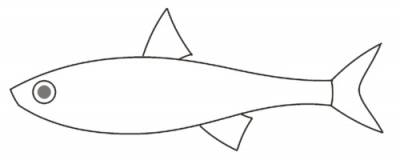More or less uniformly colored yellow, orange and red dorsal
fins without additional marks occur in many freshwater fish, first of all in
cyprinid fish such as roach, Rutilus
rutilus, rudd, Scardinius
erythrophthalmus, and more. In roach, for example, the rear part of dorsal
fin is constantly red, this fin can be folded and rise. Theoretically, roach can fold red dorsal fin
with the approaching of natural predators (like perch, Perca fluviatilis, or pike, Esox
lucius), becoming cryptic, and rise it using as red signal to contact with
schooling and sexual mates.
The
hypothesis that roach can use red dorsal fin as an important signal for school
mates is verified in these experiments.
Roach were trained in aquarium to enter the
corridor of 75 cm length, 25 cm width and 20 cm height
made of 2 mm transparent plastics. The inner walls of the corridor were treated with the sandpaper to be frosted. The
corridor was divided into the three sections of 25, 25 and 25 cm length. Roach were
trained (1 week) to feed from the small feeder in the center of the third
section. After feeding, fish could get out from the corridor get his sides or
go back. 5 fish of about 49-51 mm standard length with red
dorsal and other red fins were used. Both walls of the third section could go up to replace them. These
walls were frosted, when roach fed, and had artificial models of fish, when
they were tested on schooling preferences. The third experimental section was
divided into the three measuring areas: 10 cm area near to the first wall, 5 cm
neutral area and 10 cm area near to the second wall.
Bodies
of the fish models were made of high quality sticking foil of silver color, WTP
Inc. # 801. Dorsal, caudal and anal fins were made of neutral semitrasparent
sticking film (see Fig. 1). No pectoral and pelvic fins were imitated. In half
of the models, dorsal fins were made of sticking foil of red color, WTP Inc. #
405. All models were equipped with the 3D sticking eyes with black pupils on
the silverish background.

Figure
1. High quality artificial fish like models with bodies made of silver sticking
foil. Dorsal, caudal and anal fins are made of semitransparent sticking film.
In half of the models dorsal fins are made of red sticking foil.
In
the center of the first replaceable wall, 6 fish models with the semitrasparent
fins were sticked to imitate an oval like small school. The standard size of
all models was 5 cm. In the center of the second replaceable wall, 6 fish
models with the red dorsal fins were sticked in the same order.
To
test schooling preferences, one of the trained fish (each of 5 fish) entered
the corridor, passed him to the third section and rushed to the feeder.
However, not finding habitual feed, the fish was forced to draw its attention
to the left or right school imitations (panels). The first choice, that is
entering the left or right areas nearest to the schools, and the time spent (within
2 min period) in these areas were fixated for statistics.
In
the most laboratory tests as expected, roach moved first to the red-marked
individuals and spent more time near them (37 tests in total, sign test and Wilcoxon
signed-rank test, p < 0,05). The same results were obtained in the nature
with the same panels used with the two-flank net guide corridor: 41 tests in
total, naïve roach of 3-5 cm standard length, first choice sign test only.




